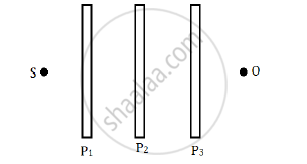Advertisements
Advertisements
प्रश्न
State and obtain Malus’ law.
उत्तर
When a beam of plane polarised light of intensity I0 is incident on an analyser, the light transmitted of intensity I from the analyser varies directly as the square of the cosine of the angle θ between the transmission axis of polarizer and analyser. This is known as Malus’ law.
I = I0 cos2θ
Proof:
- Let us consider the plane of polariser and analyser are inclined to each other at an angle θ.
- Let I0 be the intensity and ‘a’ be the amplitude of the electric vector transmitted by the polariser.
- The amplitude ‘a’ of the incident light has two rectangular components, (acos θ) and (a sin θ) which are the parallel and perpendicular components to the axis of transmission of the analyser.
- Only the component (a cosθ) will be transmitted by the analyser. The intensity of light transmitted from the analyser is proportional to the square of the component of the amplitude transmitted by the analyser.
- I ∝ (a cos θ)2 I = k(a cos θ)2
Where k is constant of proportionality.
Malus’s law
I = ka2 cos2 θ
I = I0 cos2 θ
Where, I0 = ka2 is the maximum intensity of light transmitted form the analyser.
Special cases:
Case (i):
When θ = 0°, cos 0 = 1, I = I0Case (ii):
When θ = 90°, cos 90° = 0, I = 0
APPEARS IN
संबंधित प्रश्न
Draw a neat labelled diagram showing the plane of vibration and plane of polarisation for polarised light.
Three identical polaroid sheets P1, P2 and P3 are oriented so that the pass axis of P2 and P3 are inclined at angles of 60° and 90° respectively with the pass axis of P1. A monochromatic source S of unpolarised light of intensity I0 is kept in front of the polaroid sheet P1 as shown in the figure. Determine the intensities of light as observed by the observer at O, when polaroid P3 is rotated with respect to P2 at angles θ = 30° and 60°.

What dose a polaroid consist of?
Two polaroids P1 and P2 are placed with their pass axes perpendicular to each other. An unpolarised light of intensity I0 is incident on P1. A third polaroid P3 is kept in between P1 and P2 such that its pass axis makes an angle of 30° with that of P1. Determine the intensity of light transmitted through P1, P2 and P3
Unpolarised light is passed through a polaroid P1. When this polarised beam passes through another polaroid P2 and if the pass axis of P2 makes angle θ with the pass axis of P1, then write the expression for the polarised beam passing through P2. Draw a plot showing the variation of intensity when θ varies from 0 to 2π.
With the help of an experiment, state how will you identify whether a given beam of light is polarised or unpolarized?
What does a polaroid consist of? How does it produce a linearly polarised light?
Which of the following properties shows that light is a transverse wave?
A beam of light is incident at the polarizing angle of 35° on a certain glass plate. The refractive index of the glass plate is :
A ray of light is incident on a transparent medium at a polarizing angle. What is the angle between the reflected ray and the refracted ray?
Discuss polarisation by selective absorption.
What is plane polarised light?
What is unpolarised light?
How is polarisation of light obtained by scattering of light?
The reflected light is found to be plane polarised when an unpolarized light falls on a denser medium at 60° with the normal. Find the angle of refraction and critical angle of incidence for total internal reflection in the denser to rarer medium reflection.
Polarisation of light is the only phenomenon that establishes ______.
Which of the following phenomena is not common to sound and light waves?
To ensure almost 100 per cent transmissivity, photographic lenses are often coated with a thin layer of dielectric material. The refractive index of this material is intermediated between that of air and glass (which makes the optical element of the lens). A typically used dielectric film is MgF2 (n = 1.38). What should the thickness of the film be so that at the center of the visible spectrum (5500 Å) there is maximum transmission.
